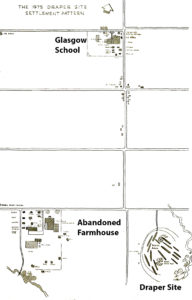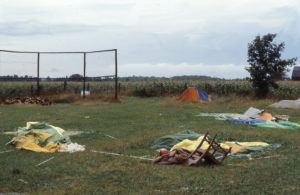One of the challenges in undertaking the excavations at the Draper site in 1975 and 1978 was ensuring the safe operation of the dig, the security of the  excavations, and providing accommodations and meals for our crews which at times numbered up to 60 people.
excavations, and providing accommodations and meals for our crews which at times numbered up to 60 people.

Figure 1 – Plan of Facilities 1975
As mentioned in my last blog post, Draper Site Field Laboratories and Crew Accommodations, we were fortunate in that there were several buildings which had been expropriated as part of the plan for the construction of the proposed new airport at Pickering. One enterprising crew member prepared a plan of our facilities (figure 1).
Shortly after beginning our work in 1975, much to our surprise, we had an unannounced Friday afternoon visit from the local Medical Officer of Health. After inspecting our kitchen and dining facilities, he informed us that we did not quite meet the required standards and gave us until Monday morning to meet the M.O.’s criteria or he would shut us down. All weekend, a number of us swept, mopped, scrubbed, polished, and disinfected. By Sunday night, we hoped we had achieved the necessary conditions and we all went out for dinner at a local restaurant. Monday morning arrived and we passed inspection with a warning to keep the facilities up to par. This was just one of the ongoing challenges to keep our crew fed and housed.

Plate 2 – Tents Flattened by Tornado
A second event marked the successful defense of his Ph.D. dissertation at University of Toronto by Peter Ramsden. The other house we used for camping had a barn and we used this for parties. On the way back to the Glasgow school after 11 p.m., I was pulled over by the local police. It turned out I had a taillight out on my Chev Carryall, and he issued a warning. But he really wanted to know what we were doing at the dig site where he had seen our vehicles coming and going. I explained what the dig was about and extended an invitation to visit. When I arrived at the site the next morning, he was already there waiting for his tour. He assured me that the police were keeping an eye on the site after hours.

Plate 3 – More Tents Down
Then there was the day a rabid fox wandered onto the Draper site while we were working. After discussing the matter with Peter, I approached Fred Draper who was still living in his house on the expropriated land and borrowed a 22-caliber pistol. We disposed of the carcass where it wouldn’t pose a hazard to the crew.

Plate 4 – Still More Tents Down
In 1978, most of the crew pitched their tents around the schoolhouse (plate 1, see feature image above). One Saturday, when I was at the school, I was sitting on the front porch and saw dark storm clouds fast approaching from the west. Before I knew it, gale force winds and driving rain arrived, and in one minute all the tents, but one, were flattened (plates 2-4). The deluge of rain soaked the downed tents and their contents. With the help of those crew still present, we cleared out the wet sleeping bags and other personal belongings and spread them around in the school to dry. I later discovered that a tornado had touched down and ripped the roof off a barn just down the road from us. Yet another interesting weekend at the Glasgow school.
These are just four of the more memorable events at Draper, which remind me of the challenges of directing the size of crews we needed to complete the largest and most significant excavations of an Iroquoian village ever undertaken in the province.
Still, one of the highlights of my career I feel fortunate to share and contribute to our archaeological history.
Sincerely,
Bill Finlayson
William D. Finlayson, Midland, Ontario
Ontario’s Leading and Senior-Most Archaeologist and Author
Founder of Our Lands Speak Book Series and Occasional Papers in Ontario Archaeology
Feature image of blog post: Plate 1 – Aerial View of Glasgow School with Crew Tents 1978 (Bill Finlayson)
All rights reserved. The use of any part of this publication reproduced, transmitted in any form or by any means, electronic, mechanical, photocopying, recording, or otherwise, or stored in a retrieval system, without the prior written consent of the author and publisher is an infringement of the copyright law. To that end, every attempt has been made to give proper acknowledgement, and access appropriate permissions for quotes. Any oversights are purely unintentional. In the unlikely event something has been missed, please accept our regret and apology, and contact us immediately so we can investigate and rectify as needed. All of the quantitative factual information is recorded in various published and unpublished sources and can be provided upon request.
